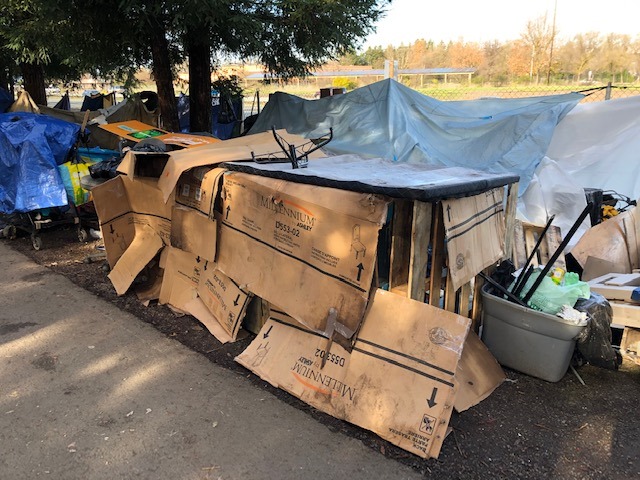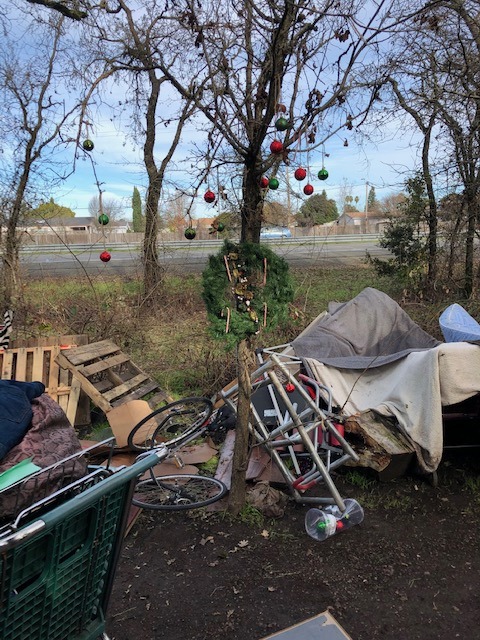
Homeless on Joe Rodota Trail, Sonoma. (Facebook)
Sonoma County Swings and Misses on Homeless Solution
Throw taxpayer money at the problem in as inefficient a manner as possible
By Phil Cowan, January 14, 2020 3:48 pm
The presence of a couple hundred filthy, trench-footed, poop-flinging thieves and a horde of disease-ridden rats probably makes for a less than pleasant bicycle ride.
For one brief moment it appeared as though someone was ready to treat California’s homelessness crisis like… well, like a crisis. An emergency. An urgent, dangerous matter requiring immediate attention.
Alas, Sonoma County, among the most beautiful places on Earth, instead chose to do what every other municipality on the brain-dead West Coast has done, which is to spend millions in taxpayer monies on feel-good, meaningless “solutions” that will do nothing to alleviate the problem. What it will do, however—and make no mistake, this is their goal—is keep the funding gravy train flowing for bureaucrats and Non-Governmental organizations (NGOs), who depend on that funding for their livelihoods. Those pitiful homeless people, and the diseases they are spreading? Hey, they’re working on it. They just need more money.
Sonoma County, like much of the West Coast, has a homelessness problem, with an estimated 3,000 unsheltered residents. Santa Rosa, the county seat, is experiencing an acute issue along the Joe Rodota Trail, a paved, off-road recreation trail that parallels State Hwy. 12 as it heads west toward Sebastopol.
The Sonoma County Parks website makes the trail sound pretty nice: …a popular route for cyclists, walkers, and runners. Its rural sections offer beautiful views of farmland, the Laguna de Santa Rosa and surrounding mountains. Fall and spring are particularly beautiful times of the year to use the trail.

Not anymore. Joe Rodota Trail is now lined with homeless camps, and the top of that same county parks web page now features this warning:
“Joe Rodota Trail users are advised to use an alternate route between Stony Point Road and South Wright roads due to safety concerns caused by illegal encampments along that trail section.”
You read that right. Illegal encampments have rendered nearly two miles of the trail unusable to the taxpayers who built and maintain it, because of unspecified “safety concerns.” In case you were wondering, these are the same “safety concerns” that seem to arise wherever the homeless gather: crime, open drug use, and an accumulation of filth that threatens public health.
According to the Santa Rosa Press Democrat:
“With no toilets, running water or trash service, the camp quickly became a public health crisis. Even the eventual approval of portable toilets and hand washing stations, regular trash pickup and numerous visits from health providers has done little to slow a burgeoning rat population or prevent the onset of trench foot among camp residents and dangerous conditions arising from cold, wet camping.”
Three uncontrolled fires have broken out in the past two months, including one sparked by the explosion of a propane tank.
Neighbors, meanwhile, have complained of stolen property, the expansion of a rat problem in their neighborhoods, trash accumulation and raw human waste hurled over shared fence lines.
Yeah, the presence of a couple hundred filthy, trench-footed, poop-flinging thieves and a horde of disease-ridden rats probably makes for a less than pleasant bicycle ride. Sounds like the county parks department made a good call in warning people off.
In response to the crisis, Lynda Hopkins, the County Supervisor for that district, proposed a bold (read: sensible) solution: dedicate space at the Sonoma County fairgrounds to get people off the street. Modeled after previous emergency responses to destructive wildfires that ravaged the county, it would consist of a mix of indoor emergency shelter, and space for outdoor campers, to accommodate those who couldn’t cope with “barracks-style” living (where they might be expected to pick up after themselves and abide by other onerous social conventions). Residents would be provided with water, heat, electricity, and bathroom facilities. There would be 24/7 security, a zero-tolerance drug-use policy and a menu of on-site social services, including medical and mental health support.
This is how emergencies should be dealt with, by taking meaningful steps to alleviate the suffering of those involved, right now, whether they’re the poor unfortunate souls living on the street, or the responsible citizens whose quality of life is being diminished because of them.
Finally, we had a homelessness proposal that made sense, for several reasons:
1) It would get people off the street and into a safer, cleaner environment and give them access to needed services;
2) It would get them away from the community’s more stable residents, who don’t deserve to have their lives invaded by dysfunction, squalor and disease; and
3) It would provide a place for the homeless to go, complying with the federal court decision in Martin v. City of Boise, in which the 9th Circuit ruled that unless a homeless camper had somewhere else to go, arresting them for illegal camping amounted to cruel and unusual punishment, which is prohibited by the U.S. Constitution. No, that isn’t exactly what our framers has in mind by “cruel and unusual punishment,” but since when did the jurists on the 9th Circuit care what the framers thought? By offering homeless campers a legal place to stay or camp, authorities would then have the option of dealing with the most chronic offenders by arresting them. After all, if we can’t treat illegal campers as if they’ve done anything illegal, then what does the word even mean?
Given the urgency of the situation, one might think the Board of Supes would take swift, decisive action to alleviate the crisis, but one would be mistaken. Instead, in the time-honored tradition of feckless government, the board has dithered for weeks, considering a nearly $12 million “suite of approaches,” including a proposal to spend $5 million on homes that would house up to 60 residents. Bear in mind, there are some 220 people living on the Joe Rodota Trail, and this group home plan would house only about 27% of them at a cost of some $80,000 each! In other words, throw taxpayer money at the problem in as inefficient a manner as possible. Then, when the $12 million “suite of approaches” fails, they’ll just break out a bigger money shovel and keep stoking.
This is the problem with the typical approach to homelessness. Our elected officials don’t really want to solve the problem because they’re much more interested in funding ineffective solutions. Their priority isn’t the suffering of the homeless, or the degradation of our quality of life; their priority is the funding. So what we get are proposals to spend $80,000-a-person on group homes, or build new apartments (as in Los Angeles) that cost $500,000-600,000 each. This is not a solution. It’s madness.
Edward Ring (California Policy Center, California Globe) and Christopher Rufo (City Journal) are among those who have written extensively about government’s addiction to budgeting huge amounts of money when it comes to dealing with homelessness. Ed Ring has named it the “homeless industrial complex,” the vast bureaucratic network of government functionaries and NGOs where people command six-figure salaries for not solving the problem. If they were to implement meaningful solutions that actually decreased homelessness, then they might have to seek employment in the private sector, where they’d be expected to do something productive and be held accountable for their job performance. Yikes! Can’t have that.

Homeless advocates will try to convince you that it’s a housing issue, but the primary reason housing is so damned expensive in California is because of government policies that make it cost-prohibitive to build anything, and Sonoma County has been at the vanguard of those policies for decades. I know, because I grew up there, and my family was in the business of building homes. Now they wonder why it costs so much to live there. They could fix that, but they don’t.
Those same advocates will also try to make the case that the people living on the streets are much the same as you or me, they just had some bad breaks. A common refrain among the homeless advocates is, “These used to be our neighbors!” No, they didn’t. In all my 63 years I never once had a neighbor who spent all day in a drug-induced haze, threw his garbage in the front yard, and routinely defecated on the sidewalk. The overwhelming majority of the homeless are not like you or me. They’re broken. Drug-addicted. Mentally ill. They’re too shattered to put their lives back together, and end up without a home or a purpose, wallowing in their own filth. Until we’re willing to tackle this aspect of the issue—force (yes, I said force) broken, dysfunctional people into mental health or drug rehab programs and holding them accountable for their life choices—the problem will only worsen. Enabling them isn’t compassionate, it is sadistic.
Homelessness is a problem years in the making, and it will take years to solve it, but the path we’re on—throwing more and more money at ineffectual programs—will never lead to success. In the meantime, we have a serious emergency on our hands, and interim, stop-gap, emergency measures are called for. Sonoma County had an opportunity to make a positive difference, and they fumbled it, just like policy makers up and down the Pacific Coast have been fumbling it for years. We need to demand more and better from our elected officials. It’s long past time to go to the ballot box and show these useless fools the door, before the entire state looks like a shantytown.
- California’s Homeless Could Provide the Answer if the Cost of Our Economic Shutdown is Worth It - March 30, 2020
- Sonoma County Swings and Misses on Homeless Solution - January 14, 2020
- Declaring California a ‘Compassionate State’ – That’ll Fix Everything - November 10, 2019





Thank you, Phil Cowan, for the informative and colorful commentary that shows us up close another piece of a trashed California. All to line the pockets of the corrupt politicians, their backers, the useless non-profits, and others. It’s just astounding that we’ve come to this.
Phil has the numbers mixed up. We don’t have 3000 unsheltered homeless. That’s roughly the total number of sheltered and unsheltered.
Paul i applaud you! You hit the nail on the head my friend! What each one of these moronic supervisors and the county are going to see in their future are countless lawsuits against them for their flagrant abuse of authority, misappropriation of funds, elder abuse, child endangerment, and the list goes on. Thank you for your efforts to put an end to this madness and truth telling.
Pick any county or town/city in CA, same story. The problem is the liberal politicians and the policies they implement. BUT, the root cause of that problem is the voters who elected them. Until voter behavior changes, nothing else will and don’t hold your breath on that happening any time soon.
Do other cities in the world tolerate this madness? I bet you ” dollars to donuts” you won’t find it in Tokyo, Manila,
New Delhi, Shanghai, and other cities rich and poor away from our madness (tolerance of indolence-lazy doped humans, just let them lay there, step away as we walk by.) The Liberal Progressive Madness rules in USA.